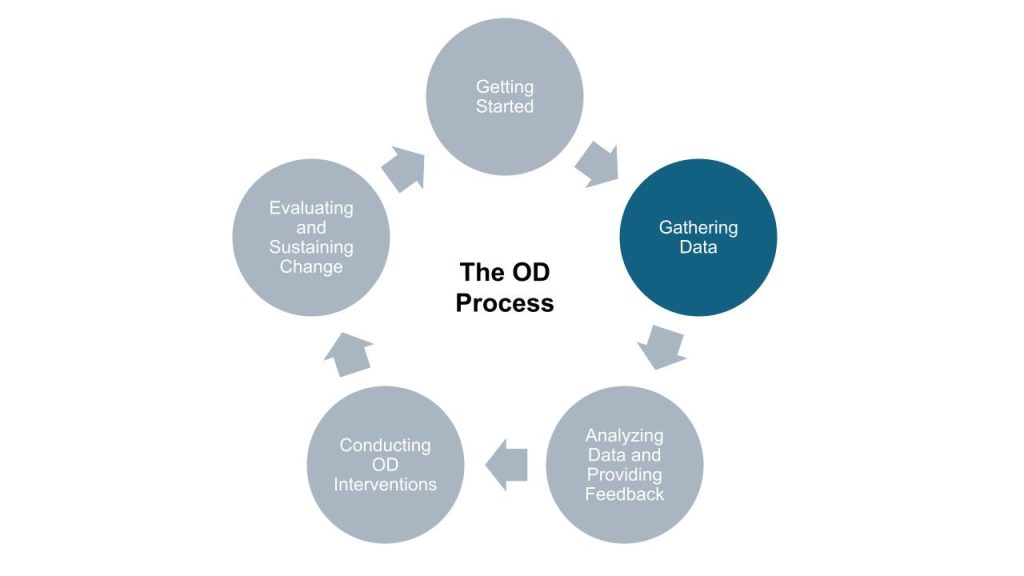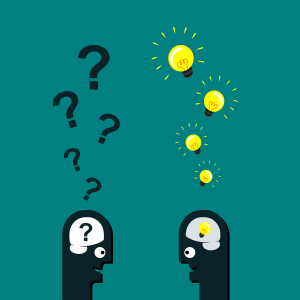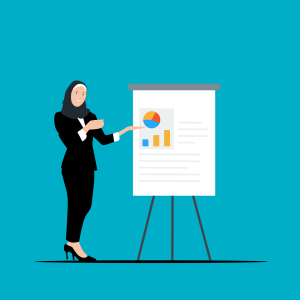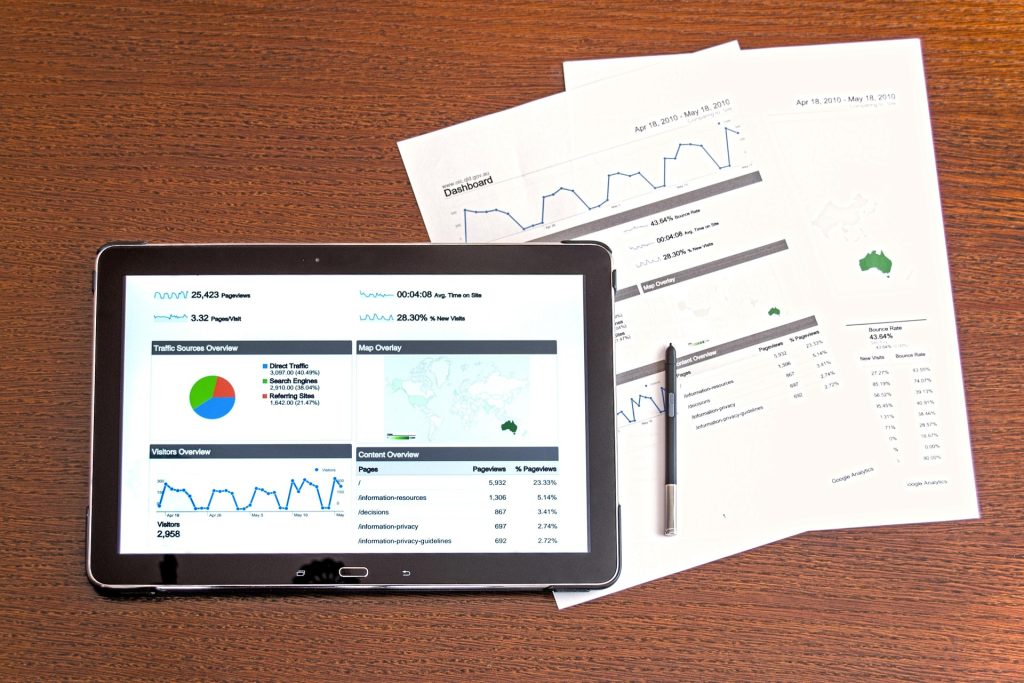Chapter Five: Data Gathering
Chapter Overview
This chapter discusses the importance of gathering and analyzing information to deeply understand organizational issues and change opportunities. We describe the most common data-gathering methods used in organizational settings (interviews, focus groups, observation, and surveys) and explain how each source and the information it provides can contribute to a broader understanding of the problem and its root causes.
Contents
5.1 Purpose of Data Gathering Stage
5.2 Common Data Gathering Methods
5.3 Process for Data Gathering
5.4 Tips for Developing OD Skills: Asking Good Questions
Questions for Reflection & Summary
5.1 Purpose of Data Gathering Stage

Data gathering and analysis is an important stage of the OD process. This is the chance for you as a change facilitator to explore the issue, question, or problems at hand for yourself. In the last chapter, we discussed the ‘presenting problem’ vs. the ‘real problem.’ The ‘real problem’ can only be uncovered through a process of data gathering and analysis. As a change facilitator, it is important to consider what those involved in the problem believe the problem is, but it is essential to dig and explore on your own in order to come to an understanding of the ‘real problem’ and its root causes. As we will explore in subsequent chapters, identifying and solving for the ‘real problem’ and not the presenting problem is a crucial step in the OD process. The presenting problem is rarely the real problem. Change facilitators should be looking for the underlying problems within a given opportunity in order to propose change that gets at the heart of it and informs the rest of the process from a place that understands the real situation at hand from a broader/or systemic perspective. Gathering and analyzing data from a variety of sources will give you, as a change facilitator, the necessary information and insight in order to move forward in the OD process successfully.
Data is also essential because it captures the voices of the individuals, teams/groups, or organizations involved in a variety of ways. While it is important to provide your preliminary understanding of the situation in advance of the diagnosis stage, it is crucial to have data to support your claims and craft your analysis using the experiences, opinions, and insights of the people who are actually involved and implicated in the change process. When used appropriately, qualitative and quantitative data can both be effective in supporting whatever claims, suggestions, or actions you take in the next steps of this process.
The data gathering and analysis stage also provides the opportunity to directly engage with the people involved in the change process and establish relationships that are based on open communication and trust regarding the goals of the change itself and making it clear that input from individuals within this group or organization is going to be taken into consideration as the change process progresses. It can create awareness about the change initiative and generate interest and energy for the change to happen, which is an important aspect to instill in any group you are trying to enact change within. Gathering data expands your knowledge of the situation and the organization as a change facilitator and can provide important information about the organization, its issues, and opportunities for change.
Qualitative vs. Quantitative Data
There are two types of data: qualitative and quantitative. Qualitative data often centers on perceptions, stories, and meanings that individuals or groups ascribe to certain experiences or things. Qualitative data gathering and analysis are interpretation-based. It asks ‘why’ and ‘how’ questions. Often, the data gathered from a qualitative method is non-measurable. On the other hand, quantitative data is highly measurable. It often contains numerically measurable or countable metrics or statistics. Quantitative data methods ask ‘how much,’ ‘how many’ or ‘how often’ questions.


Defining a data gathering approach
When defining a data gathering approach, it is important to understand exactly what you are trying to accomplish and understand. There are a variety of factors that go into determining what type of data gathering method to use, depending on the issue at hand, the number of people the change involves, and the resources you have available to gather data (time, people, money, space, etc).
There is no ‘right’ or ‘wrong’ data method to use in a particular situation. Part of the art of facilitating change is understanding which method will be the most effective depending on the issue at hand and the type of data you want to gather. Using a more effective method in an effective way will often provide you with effective data. Using a less effective method may leave you with some lingering questions or missing pieces. Often, it is necessary to select more than one method to use during the data analysis process in order to craft a more complete picture of an issue.
5.2 Common Data Gathering Methods
This section will explore some common data-gathering methods that can be leveraged within the workplace or within any other organizational context. Each of these methods is complex. There is a lot to learn about techniques and the implementation of each method. This chapter only aims to give a foundational introduction to each method in order to establish an understanding of how these methods could be used in the OD process.
Secondary Data Gathering
What is secondary data? Secondary data refers to any public, academic or institutionally available data that you did not collect yourself. Public secondary data might include federal records, national averages and statistics that are relevant to you. Some examples of this may be Bureau of Labor Statistics records, Census data, or national employment averages within your industry. Academic data might include research, white papers, and reports (although often these are more difficult to access). Institutional data may refer to historic data specifically related to your organization like turnover reports, data on the employee population, salary reports, past performance reviews, climate surveys, employee surveys, or any other documentation that individuals within your organization might hold.

What is secondary data useful for? Secondary data gathering as a method is helpful for a variety of organizational issues, topics or problems as it can give you data that helps to contextualize what is going on within your organization, or provide historical information that might be relevant. In an OD process, secondary data should always be collected. It is easy and available data that can help you triangulate and complement the other method you opt to use.
Some things to consider: There are a few things to consider when planning to use secondary data as a data gathering technique.
- Check your sources. You always want to use reliable, credible and valid sources for secondary data.
- Identify what you really need. Make sure that you are looking for secondary data intentionally. This requires really understanding what would be most helpful for you before starting the data gathering process.
- Secondary data is a good place to start before collecting your own data. It can help you educate yourself a bit more within the area that you are looking at, which can be helpful before embarking upon your process and identifying your next steps within your organizational situation.
Interview
What is an interview? An interview is one of the most common techniques for collecting data. It can be used in a wide variety of settings, including both professional and academic, and is often used within the workplace by HR professionals, managers, and OD practitioners.
Interviews typically provide a one-on-one setting between an interviewer (the person conducting the interview) and an interviewee (the person being interviewed). During an interview, the interviewer asks questions to the interviewee in order to understand their experiences and opinions on a particular topic. The data collected from an interview is considered qualitative data.
What are interviews useful for? Interviews allow you to collect in-depth understanding of experiences, perceptions, and interpretations. Interviews are useful for understanding individual experiences, gathering in-depth information on a particular topic, and discussing topics that may be of a more sensitive nature that individuals may want to talk about privately, away from other people within their broader team or organization. Interviews are also effective because they allow for more open ended questions and follow up questions. Interviews are well suited to initiate conversations or questions that begin with “Tell me what you think about….”, “What is your experience with…” This gives people the opportunity to share their opinions, points of view and experience in an in person discussion in ways that people may not want to type in a survey, for example. If the person you are interviewing brings up something you hadn’t thought of, you have the opportunity to ask them more about it during the interview.
Some things to consider when considering interviews: There are a few things to consider when planning to use interviews as a data gathering technique.
- Interviews require a significant amount of time. While there can be shorter interviews, it is difficult to have an effective interview in less than 1 hour. Because of the realities of time constraints and scheduling interviews, they are usually not effective for gathering data from a large number of people. If you are trying to collect data from an entire company that has 400 employees, interviewing each one of them is probably not going to be the most effective way to gather data. Interviews are usually conducted with 10-12 individuals, or a random sample of people, in specific positions or as representatives of specific groups. For example, the leadership team of the organization and or some members of the specific teams or departments involved in the change process would be good people to interview in order to find out more about a particular issue.
- Some people can be uncomfortable with the idea of an interview or an interview in practice. For some people, this one-one-one setting can feel intimidating and people may not feel comfortable sharing in this manner. In this situation, creating a comfortable and safe environment for people to feel free to express opinions is essential.
Focus Groups
Focus groups are facilitated group discussions, led by a moderator, that aim to collect feelings, perceptions and ideas through a group discussion on a particular issue or experience. The moderator in a focus group plays an important role. The moderator can interact with members and facilitate further discussion through follow up questions. However, the moderator should allow the focus group participants to lead the discussion. Of course, a moderator is biased as they are facilitating the focus group in order to find out more about something specific, however they should aim to facilitate the discussion in a way that is as unbiased as possible in order to make all members feel heard and safe to share. The data collected from a focus group is considered qualitative data.
What are focus groups useful for? Focus groups are useful for gathering in depth information and insights from multiple people and perspectives in a way that can be more effective than a one on one interview. The members of a focus group should be chosen intentionally. These characteristics or reasons may vary, but there should be some specific reason why these people are all in a room together discussing this particular topic. These are usually in group of 6-8 people, but the number in the group and the frequency of the focus group (once, or twice, etc) varies depending on the situation and what you are trying to understand.
Some things to consider when considering focus groups: There are a few things to consider when planning to use focus groups as a data gathering technique.
- Similar to interviews, some people may not be comfortable with being asked questions and sharing openly. Focus group settings also include more people, so responses will be heard by the facilitator and the other participants in the focus group.
- Because of multiple participants, focus groups are not well suited for questions or issues that may raise sensitive topics or responses in the discussion. There is also the potential danger of creating a bad mood or magnifying a problem if you are using a focus group to just discuss a problem. Adding questions that motivate the group to discuss ways to improve are a good way to use focus groups as brainstorming sessions on what could be done. Closing the conversation or focusing the session on strengths is a good way to balance this potential effect.
- “Groupthink” is also a potential reality with focus groups. Groupthink refers to the way that thinking or dialogue in a group of people can occasionally lead to a lack of diversity of positions or opinions. If one person shares something in a focus group, there could potentially be a pressure for others to express the same position, beliefs or opinion on something. This could stunt the ability to have an honest discussion, and facilitators of focus groups should be aware of this potential outcome and have ideas on how to guide conversations in a way that allows for multiple perspectives.
Observation
Observation is perhaps the easiest data collection method to understand, as humans naturally engage in observation all the time to discover things about the world around them. Observation as a data collection method involves observing a particular group or situation and collecting data on actual, present behavior related to how people do their work and interact.
What are observations useful for? Observations provide live, in the moment data on behaviors that may be unreported or misunderstood. Observations are easy to conduct for change makers who may have little experience collecting data, and they require little preparation and planning.
Some things to consider when considering observation:
- Observation can feel strange to those being observed. Simply by being in a space observing, the change marker is inherently changing the situation because participants know that they are being observed. This can make people feel uncomfortable or act in ways they might not normally. If choosing to use observation as a means to collect data, the change maker observing must spend time thinking about how their presence can be as unintrusive as possible.
- Observation is time consuming. To be fully immersed in observation, the change maker should be giving the observation method its full attention in the moment and not be distracted by other things. Also, because this is a time bound data collection method, observation must occur within the time frame that the situation itself is occurring in, not scheduled in the way an interview or a focus group would be. This may also leave some relevant situations “unobserved,” which is why more than one method is recommended.
Surveys
Surveys are another common data gathering technique. A survey (most often administered online) is a list of questions that aims to understand a group’s feelings on a particular topic or topics. The data collected from a survey can either be qualitative or quantitative. Survey questions that are multiple choice or rating scales will provide numeric quantitative data. Survey questions that ask people to write short answers will provide qualitative data.
What are surveys useful for? Surveys are useful for gathering information from a large number of people quickly and efficiently. Surveys often aim to gather data that is more exploratory than explanatory. Surveys can effectively and efficiently address a wide range of topics.
Some things to consider when considering surveys: There are a few things to consider when planning to use surveys as a data gathering technique.
- Surveys shouldn’t be too long or too frequent. People can lose patience or interest when completing a survey if it is too long, or if they are surveyed too many times. This is called ‘survey fatigue’. Survey questions should be clear and intentionally crafted in order to gather the data that is needed without unnecessarily adding questions to make the survey longer or more complicated so participants avoid survey fatigue.
- While short answer questions are possible on a survey, if you are looking for in-depth information, a survey may not be the best method to use. Surveys feel less personal than an interview or a focus group, and because of survey fatigue, people may not write as much in a short answer question on a survey as they might speak to in an interview. In this case, the data that the survey participants didn’t feel like writing because they were losing interest would be lost. Collecting too much qualitative data in a survey can be challenging and time consuming to analyze.
- Because of their more impersonal nature, surveys also aren’t always appropriate for more sensitive topics as their simple format may not allow for the nuance and complexity that more sensitive topics may require in order to be handled respectfully.
There are available tools that can be used to build surveys and collect data, such as Google Forms, Qualtrics or SurveyMonkey.
5.3 Process for Data Gathering
Regardless of which data collection method(s) you choose to use, there is a general process for leveraging these effectively.
- Determine the most appropriate approach to the organization and the presenting situation. The data collection method must be suited directly to the issue at hand.
- Communicate the project and data collection activity that you have chosen to the involved stakeholders. Given that open communication is essential throughout the OD process, this is an expectation at various points of the project.
- Plan and prepare the data collection process.
- Collect the data.
- Analyze and present in the Diagnosis and Feedback stage (which will be explored in the next chapter).
Triangulation
Triangulation is a research strategy that uses multiple sources of information in order to study and explore a situation. It is the process of gathering and comparing data that was collected using different methods in order to arrive at a more complete understanding of the issue. While each method will provide you with substantive information, each method is inherently incomplete on its own because of the nature of how it was conducted and the type of data collected. As we saw above, each method has pros and cons. However, if more than one method is used and triangulation is used for analysis, this process can compensate for gaps or missing information.
Ethical concerns when collecting data
As with any other step in the OD process, there are ethical concerns to be aware of. Change facilitators engaging in collecting data need to be aware of their personal bias, especially if they are a member of the organization and have knowledge or relationships with the individuals involved in the data gathering process. It is important to ensure and protect anonymity for those involved in sharing their thoughts, opinions and experiences, as employees may fear some sort of retaliation or punishment if they share controversial things. Data collected should never be used in harmful or disrespectful ways.
There are ways to ensure that the data collection process accounts for and attempts to minimize these ethical issues. Whenever possible, more than one consultant should be both collecting and analyzing data. This ensures that key themes from the data can be agreed upon and discussed with others in order to work around bias and potential oversights. A diversity of perspectives after and during the data collection and analysis perspective is essential. Also, it is important to clearly align and communicate how the data will be collected and used before starting the data-gathering process to ensure alignment of expectations.
5.4 Tips for Developing OD Skills: Asking Good Questions
Asking good questions is an important skill to develop as a change facilitator, and more broadly, as a member of an organization who has interpersonal relationships. During the data gathering stage, asking good questions can help to understand the underlying ‘real problem’ at the heart of the situation. Depending on the data gathering method you are using, questions will be used differently, and what qualifies as a ‘good’ question will vary – i.e., in interviews, open-ended questions are usually best, whereas in a survey, when using a quantitative rating scale, clear, direct questions are best. However, a ‘good’ question is always purposeful. Think clearly about exactly what you are hoping to get from the question. This will help guide your crafting of the question.
Further, asking thoughtful and intentional questions can help to make employees feel seen and heard throughout the process, and can be an important tool to establish trust with those you are working with and hoping to both help and gather information from. An important part of asking good questions is participating in active listening – listening deeply to others will help guide your questions through reflection on their thoughts and experiences. These two skills go hand in hand.
Powerful questions to help understand the root causes of a problem
- What needs improvement?
- What must be changed?
- What will have the biggest impact?
- What is working well?
- Why did this happen?
- Why have we been using this process?
- What concerns you the most about _________?
- What is holding you back from _________?
- What seems to be your main obstacle to _________?
- What do you mean by _________?
- What have you tried so far to solve __________?
- What ideas do you have to solve the situation?
- What do you think needs to happen to solve this situation?
- What else do you need to consider?
- How do you want _________ to turn out?
- In an ideal world, what would be the solution to this problem?
- What is your desired outcome?
- If the problem were solved today, what would tomorrow look like?
- What benefits would you like to get out of _________?
- Why is it important to solve this situation now?
Questions for Reflection
- Which data-gathering method would you be most interested in engaging with?
- Which one do you think you personally would be best at, given your personal strengths? Why?
- Which one do you think would be the most challenging for you? Why?
- If you were involved in a change process within your organization, what would you hope change facilitators would do or prepare in order for you to feel comfortable sharing your thoughts, feelings, and opinions in an interview or a focus group?
Summary
Gathering and analyzing data from a variety of sources will give you, as a change facilitator, the necessary information and insight in order to move forward in the OD process successfully. We explored the most common data-gathering methods used in organizational settings and explained how each source and the information it provides can contribute to a broader understanding of the problem and its root causes. However, it is important to remember to leverage multiple data gathering methods and use triangulation to get as close to understanding the ‘real’ problem as possible.
Media Attributions
- Chapter_5_OD Process_Step_2
- questions-2519654_1280
- presentation-7099081_1280
- analysis-1841158_1920
The number of persons hired within a period to replace those leaving or dropped from a workforce. It is also calculated as the ratio of this number to the number in the average force maintained. (Merriam-Webster)
questions that cannot be answered with a simple 'yes' or 'no', and instead require the respondent to elaborate on their points

